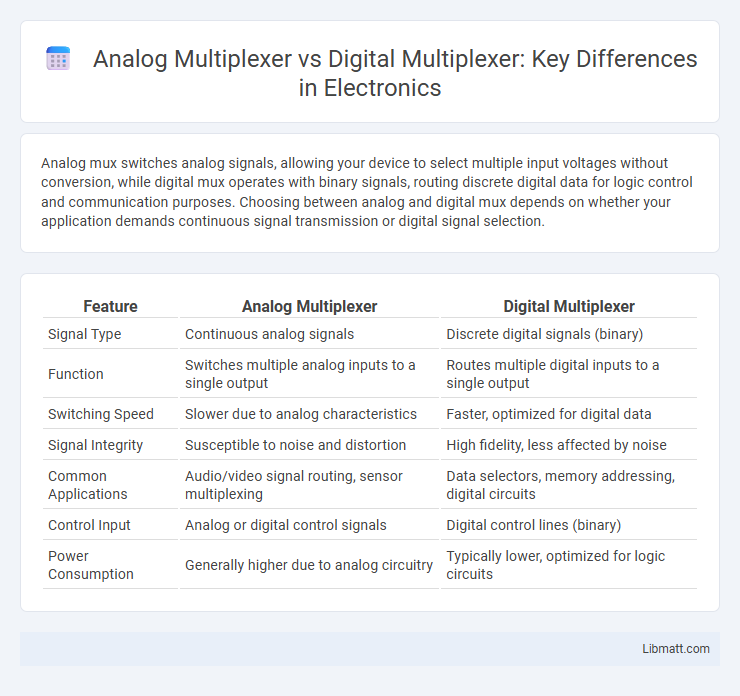Analog mux switches analog signals, allowing your device to select multiple input voltages without conversion, while digital mux operates with binary signals, routing discrete digital data for logic control and communication purposes. Choosing between analog and digital mux depends on whether your application demands continuous signal transmission or digital signal selection.
Table of Comparison
| Feature | Analog Multiplexer | Digital Multiplexer |
|---|---|---|
| Signal Type | Continuous analog signals | Discrete digital signals (binary) |
| Function | Switches multiple analog inputs to a single output | Routes multiple digital inputs to a single output |
| Switching Speed | Slower due to analog characteristics | Faster, optimized for digital data |
| Signal Integrity | Susceptible to noise and distortion | High fidelity, less affected by noise |
| Common Applications | Audio/video signal routing, sensor multiplexing | Data selectors, memory addressing, digital circuits |
| Control Input | Analog or digital control signals | Digital control lines (binary) |
| Power Consumption | Generally higher due to analog circuitry | Typically lower, optimized for logic circuits |
Introduction to Multiplexers
Multiplexers are essential devices in electronics that select one input from multiple analog or digital signals and forward it to a single output line. Analog multiplexers handle continuous voltage signals, making them suitable for audio, sensor data, or variable voltage inputs, while digital multiplexers process discrete binary signals, enabling efficient data routing in digital circuits and communication systems. Their core function optimizes resource use by allowing multiple signals to share a single transmission path, reducing complexity in wiring and circuit design.
What is an Analog Multiplexer?
An analog multiplexer (MUX) is an electronic device that selects one of several analog input signals and forwards the chosen input into a single output line. It operates with continuous voltage ranges, allowing seamless switching of analog signals such as audio, sensor outputs, or video streams without altering signal integrity. Understanding the differences between analog MUX and digital MUX helps optimize your circuit design, as digital multiplexers work exclusively with discrete binary signals while analog multiplexers handle a broader range of input voltages.
What is a Digital Multiplexer?
A digital multiplexer (MUX) is a device that selects one of several digital input signals and forwards the chosen input to a single output line based on control signals. Unlike analog multiplexers that handle continuous voltage ranges, digital multiplexers strictly process binary signals, ensuring precise logic-level data routing in digital circuits. Your design efficiency improves when using a digital multiplexer by reducing the number of data lines and simplifying complex switching operations in communication and computing systems.
Key Differences Between Analog and Digital Mux
Analog multiplexers transmit continuous voltage signals, preserving signal integrity for applications like audio and sensor data, whereas digital multiplexers handle discrete binary signals essential for digital circuits and computing. Analog MUX devices often feature low on-resistance and high linearity to minimize signal distortion, while digital MUXs prioritize fast switching speeds and noise immunity for reliable digital signal processing. The key difference lies in their signal type compatibility and performance characteristics tailored to analog signals' amplitude variation versus digital signals' logic levels.
How Analog Multiplexers Work
Analog multiplexers work by selecting one of several analog input signals and forwarding the chosen signal to a single output line, using control signals to determine the active channel. Unlike digital multiplexers that handle discrete binary signals, analog MUXs maintain the continuous voltage or current levels of inputs without digitization. The internal switches, often implemented with CMOS transistors, enable low-resistance conduction paths, ensuring minimal signal distortion and loss during signal routing.
How Digital Multiplexers Operate
Digital multiplexers operate by selecting one of several digital input signals and forwarding the chosen input to a single output line based on binary control signals. These control inputs determine which data line is connected, allowing multiple data streams to be managed efficiently within digital circuits. Unlike analog multiplexers, digital multiplexers handle discrete signals and are essential in applications such as data routing, signal switching, and logic function implementation.
Common Applications of Analog Multiplexers
Analog multiplexers are commonly used in data acquisition systems, sensor interfacing, and audio or video signal routing where multiple analog inputs need to be selectively connected to a single output for measurement or processing. These devices enable efficient sampling in multichannel analog-to-digital converter systems and simplify circuit design by reducing the number of required input channels. Unlike digital multiplexers, which handle discrete binary signals, analog multiplexers maintain the continuous voltage levels of analog signals, making them ideal for real-time signal monitoring and control in industrial automation and medical instrumentation.
Common Applications of Digital Multiplexers
Digital multiplexers are commonly used in data routing, allowing multiple digital signals to share a single communication line, thus optimizing bandwidth utilization. They serve critical roles in microprocessor data selection and bus arbitration, enabling efficient control of data flow within digital systems. Digital multiplexers are also essential in communication networks for signal switching and in memory management to select specific data sources for processing.
Pros and Cons: Analog Mux vs Digital Mux
Analog multiplexers efficiently handle continuous signals with minimal distortion, making them ideal for audio and sensor applications; however, they suffer from signal degradation and limited channel isolation. Digital multiplexers excel in routing discrete digital signals with high speed and accuracy, providing better noise immunity and scalability but may introduce latency and power consumption concerns. Choosing between analog and digital MUX depends on signal type, required fidelity, switching speed, and application-specific constraints.
Choosing the Right Multiplexer for Your Project
Selecting the right multiplexer depends heavily on whether your project requires analog or digital signal handling, as analog multiplexers efficiently route varying voltage levels, while digital multiplexers switch between binary signals. Your choice should consider signal integrity, bandwidth, and switching speed, with analog muxes excelling in audio and sensor applications, and digital muxes suited for logic circuits and data routing. Evaluating these parameters ensures optimal performance and compatibility in your electronic design.
Analog Mux vs Digital Mux Infographic

 libmatt.com
libmatt.com